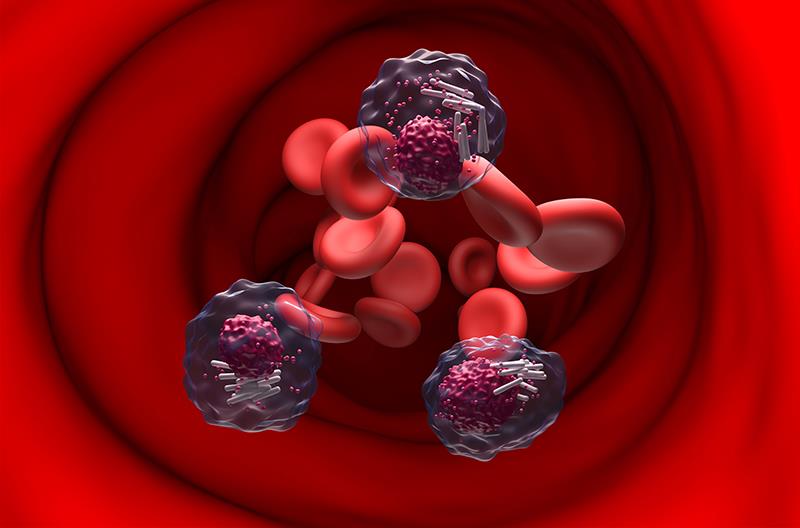Acalabrutinib-venetoclax hits mark for fit TN CLL patients





The interim analysis of the AMPLIFY trial provides the first phase III evidence of fixed-duration therapy combining a second-generation Bruton tyrosine kinase inhibitor (BTKi) with venetoclax with or without anti-CD20 for treatment-naïve (TN) chronic lymphocytic leukaemia (CLL).
After a median follow-up of 40.8 months, fixed-duration acalabrutinib + venetoclax with (AVO) or without obinutuzumab (AV) improved progression-free survival (PFS) in fit patients with TN CLL, said Dr Jennifer Brown from the Dana-Farber Cancer Institute, Boston, Massachusetts, US, at ASH 2024.
AV and AVO provided statistically significant improvements in IRC*-assessed PFS vs FCR/BR** (hazard ratio [HR], 0.65; p=0.0038 and HR, 0.42; p<0.0001, respectively). Median PFS was not reached (NR) with both AV-based regimens and 47.6 months with FCR/BR. Estimated 3-year PFS rates for AV, AVO, and FCR/BR were 76.5, 83.1, and 66.5 percent, respectively. [ASH 2024, abstract 1009]
Results of the PFS analysis after censoring COVID-19 deaths aligned with that of the primary analysis (HR, 0.71; p=0.0356 [AV] and HR, 0.26; p<0.0001 [AVO]). Median PFS was NR with AV and AVO and 49.2 months with FCR/BR, with PFS rates of 78.8, 91.5, and 72 percent, respectively.
PFS in subgroups
Similar patterns favouring AV and AVO over FCR/BR were seen in the uIGHV*** (HRs, 0.69 and 0.35, respectively) and mIGHV*** subgroups (HRs, 0.67 and 0.58). Of note, the 3-year estimated PFS rates for AVO were essentially identical in both subgroups (82.8 percent and 83.6 percent), suggesting that patients with uIGHV may derive particular benefit from the addition of obinutuzumab, said Brown.
These trends were likewise observed in the uMRD# (HRs, 0.43 and 0.27 for AV and AVO, respectively) and MRD-positive subgroup at end of therapy (EOT; HRs, 0.44 and 0.70).
The AVO arm had the highest uMRD rates at EOT in both the intent-to-treat (67.1 percent) and evaluable patient cohorts (95 percent).
Overall survival, safety
Overall survival (OS) was prolonged with AV vs FCR/BR in the primary analysis (HR, 0.33; p<0.0001). After censoring COVID-19 deaths, both AV and AVO were tied to longer OS than FCR/BR (HRs, 0.27 and 0.47).
In the respective AV and AVO arms, the rates of serious adverse events (AEs) were 24.7 percent and 38.4 percent, serious AEs leading to death were 3.4 percent and 6 percent, while AEs leading to treatment cessation were 7.9 percent and 20.1 percent.
The most common grade ≥3 AEs across all arms was neutropenia (26.8, 35.2, and 32.4 percent in the AV, AVO, and FCR/BR arms, respectively).
About a quarter of AV and AVO recipients had a COVID-19 AE (22 percent and 24.3 percent), with 2.4 percent and 8.1 percent discontinuing treatment due to a COVID-19 AE.
With the AV-based regimens, grade ≥3 cardiac events (~2 percent) and atrial fibrillation (<1 percent) were rare. There were no reports of grade ≥3 ventricular tachyarrhythmias.
The first all-oral fixed-duration regimen for TN CLL
Fixed-duration venetoclax and ibrutinib induces deep, durable responses, but cardiac toxicity remains a concern, particularly among older patients. [NEJM Evid 2022;doi:10.1056/EVIDoa2200006; Lancet Oncol 2023;24:1423-33; Haematologica 2017;102:1796-1805] “Acalabrutinib is a highly selective BTKi with improved safety and tolerability vs ibrutinib,” said Brown.
In AMPLIFY, 867 participants (median age 61 years, >60 percent men) were randomized 1:1:1 to oral acalabrutinib 100 mg BID (cycles 1–14) + oral venetoclax 400 mg QD (cycles 3–14), AV + IV obinutuzumab 1,000 mg (cycles 2–7), or six cycles of investigator’s choice of FCR/BR. About 60 percent had uIGHV, while >40 percent were Rai stage III–IV.
“AMPLIFY met its primary endpoint, demonstrating superior IRC-assessed PFS with AV vs FCR/BR, with similar findings seen with AVO vs FCR/BR,” noted Brown and colleagues.
“The combinations of AV and AVO provided deep and durable responses with manageable safety profiles. [AV offers] the first all-oral fixed-duration regimen that combines venetoclax with a second-generation BTKi in fit patients with TN CLL,” they said.